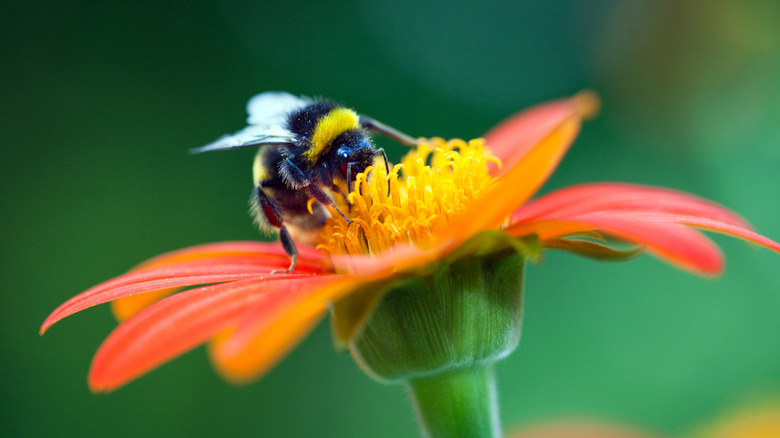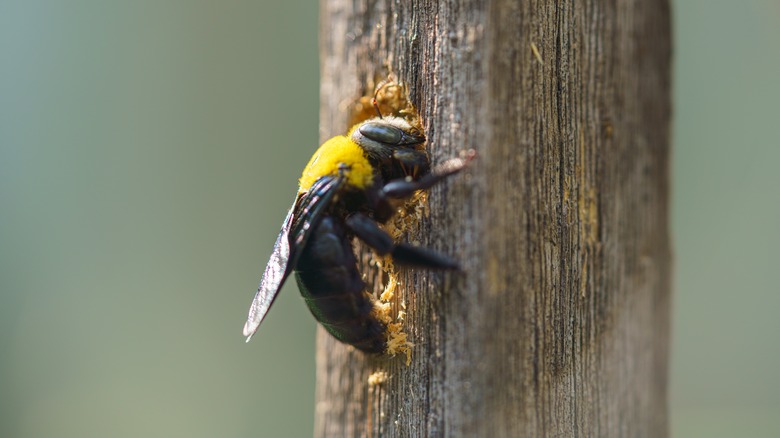Carpenter Bees Vs Bumble Bees: What's The Difference & Which Is In Your Yard?
There are at least 20,000 different species of bees in the world. Many people grow bee-friendly flowers to attract more of these buzzing pollinators to their gardens, but do you know which type is in your yard? It can be hard to tell, as a lot of these bees, including carpenter bees and bumble bees, look very much alike. Many bees, like the bumble bee, have tiny hairs that give them sort of a furry appearance. When located on the abdomen, that fuzz helps them do their job as pollinators for a wide variety of plants. Not all bees have a hairy abdomen, though, which is one of many ways you can tell a bumble bee from a carpenter bee.
Many of the distinguishing behaviors of each type of bee have to do with how these interesting insects live day to day and rear their offspring. Bumble bees are social insects living in colonies, for instance, whereas carpenter bees are not. Even if you don't feel comfortable getting super close to the bees frequenting your yard, you can look for some other telltale signs that you've got carpenter bees buzzing around instead of bumble bees, or vice versa.
Identifying bumble bees
Bumble bees are quite a bit larger and fuzzier when compared to other bees you might commonly see in your yard, with vivid yellow (or orange on rare occasions) and black coloring. As previously mentioned, they also sport a furry belly that helps them gather pollen. Bumble bees also hold pollen they gather for food in receptacles behind their legs making them seem even larger when they're carrying a full load. You won't see bumble bee queens often, but they're double the size of the others in the colony. And while you might not ever want to get close enough to figure this out, the females in the bumble bee world have pointy bodies terminating with a stinger whereas the male's abdomen is rounded and has no stinger.
You'll want to keep an eye underfoot when you're distinguishing bumble bees from carpenter bees. Being social insects, bumble bees live in a colony underground. If you see bees buzzing around your yard traveling in and out of a ground-based hole, that's a clue you're dealing with bumble bees. Within the nest, eggs are laid on pollen that has been collected, and the bumble bee larvae feed on it until they reach adulthood a few weeks later. While they don't store honey that can be harvested, these colonies do serve the useful purpose of pollinating several types plants that don't respond as well to the efforts of other types of bees.
How to identify carpenter bees
Sometimes carpenter bees are mistaken for bumble bees since they are similar in size and color at first glance. The bellies of all carpenter bees, however, are hairless, smooth, and shiny black. Male carpenter bees have yellow hairs on their heads, and while they don't have stingers, they will buzz around in a frenzy to scare aware anything they perceive to be a threat, including humans. Female carpenter bees are solid black and do have stingers, but they don't often use them.
One of the most helpful ways to tell if you have carpenter bees near your home is by noticing where they nest. Carpenter bees are sometimes called "wood bees" since they bore ½ inch entrance holes into their nests — called galleries — that are so precise they look like they were made by a mechanical tool. A nesting carpenter bee may reuse an old gallery or bore a new one. Once inside the wood, the bees carve out tunnels ranging on average from 4 to 6 inches in length, but they can reach 10 feet long when reused from year to year. A mated female will then put a blend of pollen and nectar in place before laying eggs on top of it; a new bee will make its appearance about six weeks later. So, if you're seeing unexplained round holes in the wood on your property where insects are entering and exiting, you probably have carpenter bees rather than bumble bees.


